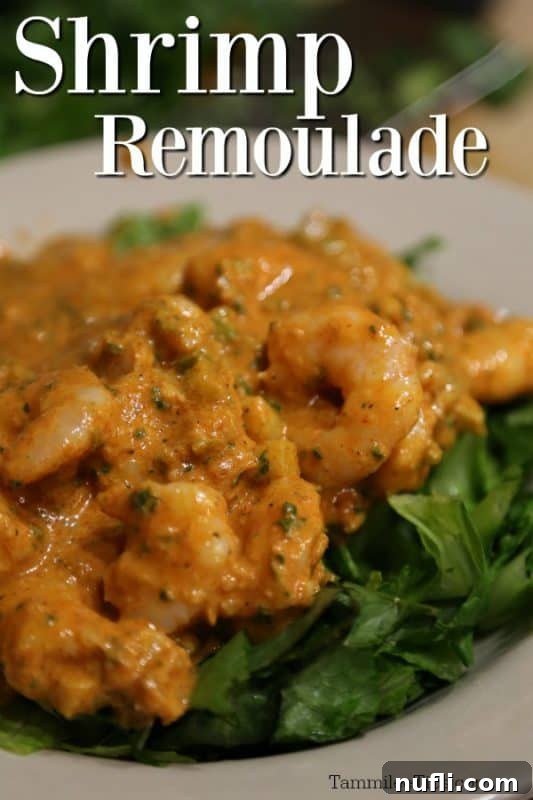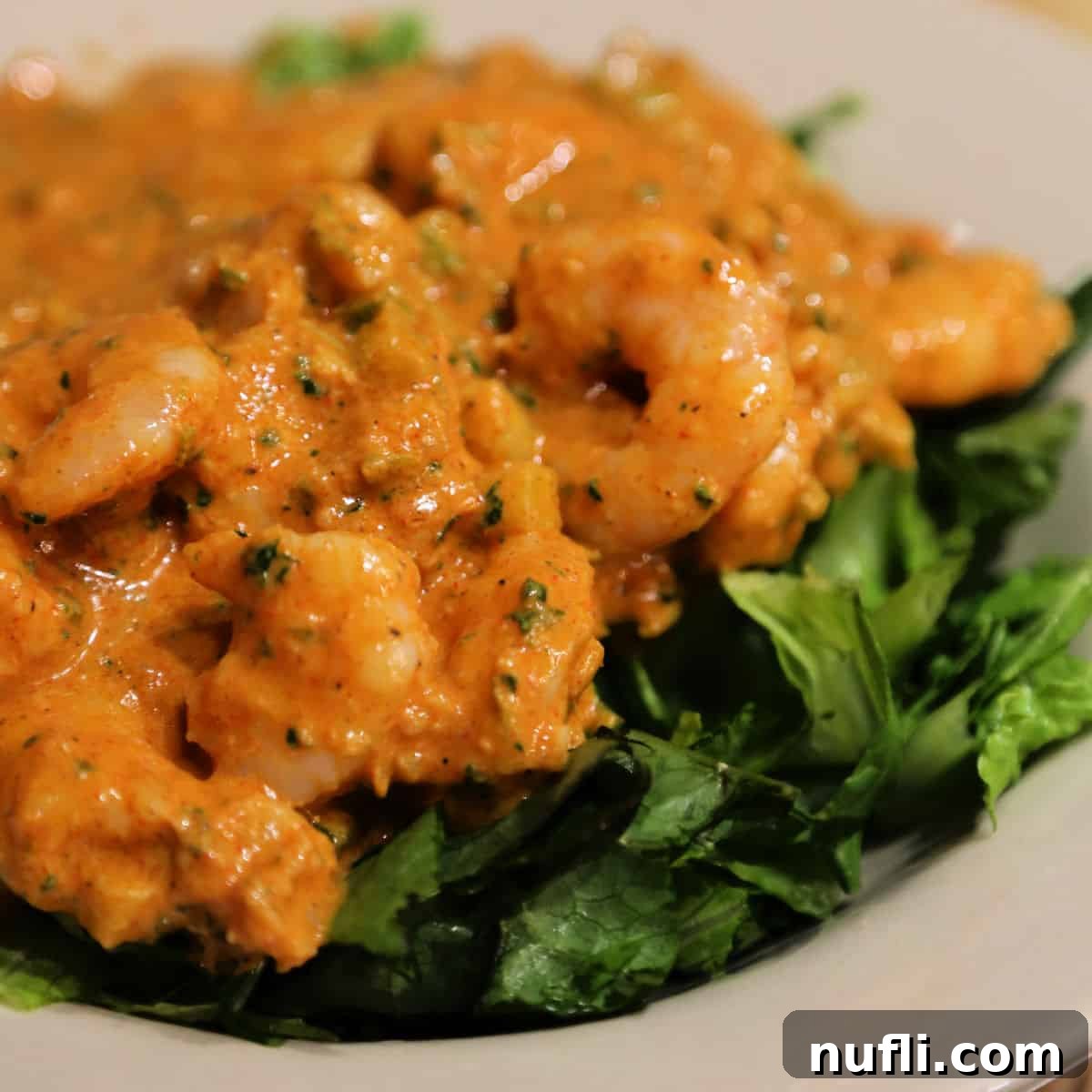Welcome to a culinary journey that takes us straight to the heart of New Orleans, where vibrant flavors and rich traditions come alive. Today, we’re thrilled to share our authentic Shrimp Remoulade recipe, a dish we first encountered and mastered during an unforgettable cooking class in the Crescent City. Before that immersive experience, the concept of remoulade was a delightful mystery to us, let alone how to craft it from scratch. We quickly discovered that Shrimp Remoulade isn’t just a dish; it’s a beloved staple, deeply ingrained in New Orleans’ esteemed culinary landscape.
The secret to its unparalleled taste often lies in the freshness of its ingredients. Picture succulent shrimp, harvested from the pristine waters of the Gulf of Mexico, forming the perfect canvas for a sauce that’s both zesty and robust. While savoring this dish in New Orleans is an experience in itself, we understand that not everyone lives near the Gulf. That’s why we’re bringing this incredible Shrimp Remoulade recipe to your kitchen, allowing you to recreate the magic of Louisiana no matter where you are. Get ready to impress your taste buds and transport your senses to the bayou with every bite of this iconic New Orleans classic.

The Allure of New Orleans Shrimp Remoulade
Shrimp Remoulade holds a special place in the pantheon of New Orleans cuisine. It’s a versatile dish, often served as an appetizer, a light lunch, or even as part of a grander seafood spread. The beauty of this recipe lies in its simplicity and the complexity of its flavors. It’s a testament to the city’s ability to take classic French culinary techniques and infuse them with distinctly Louisiana ingredients and a Creole flair that makes them uniquely its own.
Our journey to perfect this recipe began at the renowned New Orleans School of Cooking, where we previously learned the secrets to an amazing Jambalaya recipe. It was during this same class that we were introduced to the vibrant world of Remoulade Sauce, a perfect accompaniment to seafood and a dish that truly shines when paired with freshly cooked shrimp. The experience of learning to create these dishes together was not just educational but also a wonderfully romantic activity during our weekend getaway in New Orleans. There’s something incredibly satisfying about cooking a delicious meal from scratch and then enjoying the fruits of your labor.

We absolutely cherish the memories of that class, especially seeing the joy and pride on my husband’s face as he showcased our freshly made remoulade sauce. Those shared cooking moments are priceless, and they remind us that the best recipes are often those made with love and a touch of adventure. Now, let’s dive into how you can bring that same joy and flavor into your own home.
Understanding Remoulade: A Sauce with Character
At its core, remoulade is a mayonnaise-based sauce, but the New Orleans version elevates it to an art form. Unlike its traditional French counterpart, which often leans towards a more delicate, herb-infused profile, Creole remoulade explodes with a robust combination of mustard, horseradish, and a medley of spices. This creates a sauce that is bold, tangy, and boasts a delightful kick, perfectly complementing the sweet, tender meat of shrimp.
The magic happens when these flavors meld, creating a creamy yet spicy dressing that coats each shrimp with an irresistible zest. It’s a testament to the ingenuity of Creole cuisine, which consistently transforms simple ingredients into extraordinary dishes. The vibrant paprika gives it that signature reddish-orange hue, making it as visually appealing as it is delicious. This is not just a condiment; it’s an experience in itself, offering a burst of flavor that awakens the palate and leaves you craving more.
Choosing and Preparing Your Shrimp: The Foundation of Flavor
The quality of your shrimp is paramount to the success of this dish. When possible, opt for fresh, medium-sized shrimp, preferably wild-caught from the Gulf of Mexico. Gulf shrimp are known for their sweet flavor and firm texture, which stand up beautifully to the rich remoulade sauce. If fresh Gulf shrimp aren’t available, high-quality frozen shrimp can be an excellent alternative. Just ensure they are properly thawed before cooking.
Tips for Selecting the Best Shrimp:
- Freshness: Look for shrimp that are firm, translucent, and have a mild, oceanic scent. Avoid any with a strong, fishy odor or slimy texture.
- Size: Medium shrimp are ideal for remoulade, as they are bite-sized and hold the sauce well without being too overwhelming.
- Source: If you can find wild-caught shrimp, they often have a superior flavor and texture compared to farmed varieties.
Preparing Shrimp for Optimal Taste:
Proper preparation ensures your shrimp are tender and succulent. Peeling and deveining the shrimp (removing the dark vein along its back) is a crucial step for both aesthetics and taste. While some prefer to leave the tails on for presentation, for a dish like shrimp remoulade where the shrimp are coated in sauce, removing them makes for easier eating.
The cooking method we learned in New Orleans is simple yet effective: a quick boil in seasoned water. This poaching technique ensures the shrimp cook evenly and remain tender without becoming rubbery. The key is not to overcook them, as shrimp cook very quickly.
Crafting the Authentic New Orleans Remoulade Sauce: A Symphony of Spices
The remoulade sauce is undeniably the star of this dish, providing the signature flavor profile that makes it so unforgettable. It’s a meticulous balance of tang, spice, and creaminess, each ingredient playing a crucial role in the final symphony of taste.
Essential Remoulade Sauce Ingredients and Their Contributions:
- Olive Oil: Forms the rich, smooth base of the sauce, providing a luxurious mouthfeel.
- Salt: Essential for enhancing all the other flavors and ensuring the sauce is well-seasoned.
- Vinegar: Adds a crucial tangy acidity that cuts through the richness and brightens the sauce.
- White Horseradish: Delivers a sharp, pungent kick that is characteristic of New Orleans remoulade, providing a thrilling warmth.
- Creole Mustard: This is arguably the most defining ingredient. Unlike milder Dijon or yellow mustards, Creole mustard offers a coarser texture and a distinct, spicy, earthy flavor that is indispensable for authentic remoulade.
- Mayonnaise: Provides the creamy texture and binds all the ingredients together, creating a smooth and luscious sauce.
- Paprika: Contributes a beautiful reddish hue and a mild, peppery sweetness that rounds out the spice profile.
- Celery (minced): Adds a fresh, crisp texture and a subtle peppery, aromatic flavor that’s a hallmark of Louisiana cooking.
- Ground Black Pepper: Provides a classic spicy bite and depth of flavor.
- Parsley (minced): Offers a fresh, herbaceous note and a vibrant green color, adding freshness to the rich sauce.
- Onion (minced): Contributes an aromatic sweetness and a slight pungent edge, building complexity.
Tips for Blending the Perfect Remoulade:
The key to a truly great remoulade is thorough mixing and allowing the flavors time to meld. While it can be enjoyed immediately, the sauce often tastes even better after an hour or two in the refrigerator, giving the spices and aromatics a chance to fully integrate. Aim for a creamy, spreadable consistency that will generously coat the shrimp.
Your Authentic New Orleans Shrimp Remoulade Recipe
This recipe brings together perfectly cooked shrimp with a homemade, zesty remoulade sauce, capturing the true essence of New Orleans. With a prep time of just 20 minutes and a cook time of 5 minutes, you can have this delightful dish ready in about 25 minutes, serving 5 people. Each serving provides approximately 554 calories, making it a satisfying appetizer or light meal.
Shrimp Ingredients
- 1 pound medium shrimp (heads off)
- ½ teaspoon ground red pepper
- ½ teaspoon ground white pepper
- ½ teaspoon black pepper
- 1 quart water
- 2 Tablespoons salt
Remoulade Sauce Ingredients
- 1 Cup olive oil
- 1 ½ teaspoon salt
- 1 cup vinegar
- ½ cup white horseradish
- 1 ⅓ cup Creole mustard
- ¼ cup mayonnaise
- ⅓ cup paprika
- 3 cups celery, minced
- 1 Tablespoon black pepper
- ⅔ cup parsley, minced
- ⅓ cup onion, minced
Shrimp Instructions
- Peel and devein the shrimp. This step ensures cleaner shrimp and better presentation.
- Bring the water, 2 tablespoons of salt, red pepper, white pepper, and ½ teaspoon of black pepper to a full boil in a medium saucepan over high heat. The seasoned water will infuse the shrimp with flavor.
- Drop the peeled and deveined shrimp into the boiling water and stir continuously. Cook over high heat for only 2-3 minutes. It’s crucial not to overcook the shrimp, as they can quickly become rubbery.
- The shrimp should turn pink and firm when cooked through. Immediately drain the shrimp and transfer them to a bowl of ice water. This “shocking” process stops the cooking and keeps them tender.
Remoulade Sauce Instructions
- In a large mixing bowl, combine the olive oil, 1 ½ teaspoons of salt, vinegar, Creole mustard, paprika, 1 tablespoon of black pepper, horseradish, and mayonnaise. Whisk until all ingredients are thoroughly combined and the sauce is smooth.
- Add the minced celery, parsley, and onion to the bowl. Mix well to ensure the aromatics are evenly distributed throughout the sauce.
- Once the shrimp are cooled, drain them thoroughly from the ice water. Place the shrimp in the bowl with the remoulade sauce and mix gently until every shrimp is beautifully coated.
For the best flavor, allow the Shrimp Remoulade to chill in the refrigerator for at least 30 minutes before serving. This allows the flavors to deepen and meld, creating a truly exceptional dish. Serve it generously over a crisp bed of lettuce or get creative with other serving suggestions!
Serving Suggestions and Culinary Pairings
While serving Shrimp Remoulade over a crisp bed of lettuce is a classic presentation, the versatility of this dish allows for numerous creative serving options. Here are a few ideas to elevate your Shrimp Remoulade experience:
- Remoulade Po’boys: For a true taste of New Orleans, pile the sauced shrimp into a crusty French bread loaf with shredded lettuce and sliced tomatoes.
- Appetizer Spoons or Skewers: Serve individual portions on elegant appetizer spoons or skewer a few shrimp with cherry tomatoes for a sophisticated party bite.
- With Crackers or Crostini: Offer a bowl of Shrimp Remoulade with a side of your favorite crackers, toasted baguette slices, or crostini for a delightful dip.
- As a Side Dish: It pairs wonderfully with other seafood dishes, grilled chicken, or even as a unique topping for deviled eggs.
- Salad Topping: Transform a simple green salad into a gourmet meal by topping it with a generous scoop of Shrimp Remoulade.
Frequently Asked Questions About Shrimp Remoulade
Can I make Remoulade Sauce ahead of time?
Absolutely! Remoulade sauce often tastes even better when made a day in advance. This allows the complex flavors of the mustard, horseradish, and spices to fully meld and deepen. Store it in an airtight container in the refrigerator for up to 3-4 days.
How long does Shrimp Remoulade last?
Once the shrimp are mixed with the remoulade sauce, it’s best to consume the dish within 1-2 days. The acidity in the sauce helps preserve the shrimp, but for optimal freshness and safety, avoid storing it for too long.
What’s the difference between New Orleans Remoulade and French Remoulade?
The main difference lies in the ingredients and flavor profile. Traditional French remoulade is often lighter, featuring capers, gherkins, herbs like tarragon and chervil, and a less spicy mustard. New Orleans (Creole) remoulade is distinctively bolder and spicier, characterized by the prominent use of Creole mustard, horseradish, paprika, and a more robust blend of peppers and aromatics.
Can I use frozen shrimp?
Yes, good quality frozen shrimp can be used. Ensure they are fully thawed in the refrigerator before peeling, deveining, and cooking. Pat them dry before cooking to prevent excess water from diluting the flavors.
What type of vinegar is best for Remoulade?
White vinegar or cider vinegar are common choices that provide the necessary tang. Some recipes might use red wine vinegar for a slightly different flavor profile. Choose one that complements the other strong flavors in the sauce.
Explore More New Orleans & Southern Recipes
Our culinary adventures in New Orleans have inspired us to share many more delicious recipes that capture the spirit of Southern cooking. If you enjoyed this Shrimp Remoulade, be sure to check out some of our other favorites:
- Cinnamon Roll King Cake
- New Orleans Spicy Barbecue Shrimp
- Shrimp and Grits Crockpot Recipe
- Slow Cooker Gumbo
- Pimm’s Cup
- Smoked Sausage Po’Boys
- Jambalaya
Do you love discovering new recipes? Be sure to explore our extensive collection of copycat recipes, irresistible dessert recipes, and our convenient CrockPot Recipes for easy weeknight meals.
Nutrition Information
Nutrition Facts
Shrimp Remoulade Recipe
Amount Per Serving
Calories 554 | Calories from Fat 495
% Daily Value*
- Fat 55g (85%)
- Saturated Fat 8g (50%)
- Cholesterol 5mg (2%)
- Sodium 4383mg (191%)
- Potassium 489mg (14%)
- Carbohydrates 12g (4%)
- Fiber 7g (29%)
- Sugar 3g (3%)
- Protein 5g (10%)
- Vitamin A 4614IU (92%)
- Vitamin C 14mg (17%)
- Calcium 107mg (11%)
- Iron 4mg (22%)
* Percent Daily Values are based on a 2000 calorie diet.
Connect with Us for More Delicious Recipes!
Don’t miss out on our latest culinary inspirations and travel adventures. Follow Tammilee Tips on Facebook, Instagram, and Pinterest for all our recipe posts and more!
Love this recipe? Follow @TammileeTIps on Pinterest!
Tried this recipe? Mention @TammileeTipsLife when you share a photo on Instagram!
Recipe originally shared on May 3, 2015. Updated December 2020. This article has been further expanded and optimized for SEO.
